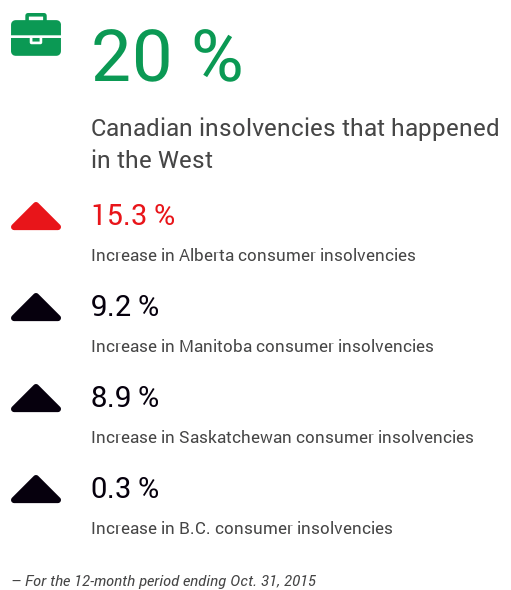An increasing number of consumers and businesses across the four western provinces are expected to face insolvency this year as low commodity prices drive the economic turmoil that began in 2015.
As the economic turmoil continues, we can expect to see this trend increase over the next year especially if commodity prices remain as low as they were in 2015.
Consumers make up the bulk of insolvencies reported each month. According to Statistics Canada, the most recently reported consumer debt-to-disposable income ratio is at an all-time high of 163.7% in the third quarter of 2015. Consumer debt has grown as consumers respond to lower interest rates to purchase higher-priced housing.
In Alberta, the full impact of the downturn has not yet hit consumers. One Alberta economist writes that the full effect of layoffs on consumers may be delayed, as many received severance packages that would tide them over in the short-term. As well, lower interest rates will help some consumers to manage mortgage payments and other debt through the down-cycle.
With bank economic forecasts suggesting Canada’s economic growth rate will be just below 2% this year, it will be more challenging than ever for consumers and businesses to keep their debt at manageable levels.
Total insolvencies
Overall, about 20% of Canadian insolvencies happen in western Canada, including both bankruptcies and proposals to creditors. (Insolvency is when a consumer or business can’t pay outstanding debts and need to find a solution, whether through bankruptcy – an extreme solution – or a creditor proposal.)
For the 12-month period ending Oct. 31, 2015, only British Columbia experienced a decrease in the number of consumer and business insolvencies. The other three western provinces all experienced an increase. Not surprisingly, Alberta led with 14.8% more consumer and business insolvencies than the year before.
From September to October 2015, Manitoba experienced the greatest increase in the number of insolvencies filed, with 6.3% followed by Saskatchewan at 1.5% and Alberta at 0.2%. Only British Columbia experienced a 5.1% decline in total insolvency filings.
Consumer insolvencies
All western Canadian provinces experienced an increase in the number of consumer insolvencies filed over the 12-month period ending Oct. 31, 2015. Alberta consumers were the hardest hit with a 15.3% increase over the year, followed by Manitoba with 9.2%, Saskatchewan at 8.9% and British Columbia with a slight increase in the number of insolvencies at 0.3%.
Consumers in Saskatchewan faced the largest monthly increase, with 6.2% more insolvencies filed in October than September. Manitoba followed closely behind with 5.8%, and Alberta experienced a less than one per cent increase in consumer filings. British Columbia reported 5.7% fewer consumer insolvency filings in October from September 2015.
Business insolvencies
Across Canada, the 12-month period ending October 2015 saw insolvency increases in several sectors closely aligned with the natural resource sector including: construction (4.7%), transportation and warehousing (1.6%), professional, scientific and technical services industries (4.1%) and management of companies (3.5%).
For the 12-month period ending October 2015, all provinces saw a decrease in the number of business insolvencies.
The change from September to October 2015 showed a different picture. The percentage of insolvencies filed increased in Manitoba (33.3%) and British Columbia (21.7%) while the percentage decreased for Saskatchewan (-40.0%) and Alberta (-33.3%).
– Janice Plumstead is a Senior Economist

